Abstract
Abstract
Anteo is a tribute by José Manuel Caballero Bonald to flamenco singing. The social background that served as the cradle of flamenco art, as well as its main sources of inspiration, shines through in the text. The perpetual human tragedy linked to art implies the notion of timelessness. The generalization of pain and its timeless character favor the mythologizing of cante and the ritualization of the spectacle offered by the voice. The purpose is to evacuate the accumulated sorrow knowing that it will never completely disappear. The reflection on the language derives towards the verbalization of musical concepts -rhythm, harmony, breaks, times and silences- placed at the service of the singer so that he leads his audience to the peak of emotion through the different manifestations of a cry that ends up reaching aesthetic vigor.
References
Abril, Juan Carlos (2018). El habitante de su palabra. La poesía de José Manuel Caballero Bonald, Madrid, Visor.
Bois, Mario (2016). Le flamenco dans le texte, Biarritz, Atlantica.
Caballero Bonald, José Manuel (2011). «Anteo», Somos el tiempo que nos queda. Obra poética completa 1952-2009, Barcelona, Austral, pp. 129-139.
Caballero Bonald, José Manuel (1983). Selección natural, Madrid, Cátedra.
Caballero Bonald / Colita (2006). Luces y sombras del flamenco, Sevilla, Fundación José Manuel Lara.
García Jambrina, Luis (2000). La promoción poética de los 50, Madrid, Austral.
García Lorca, Federico (2018). Poema del cante jondo. Romancero gitano, Madrid, Cátedra.
Grimaldos, Alfredo (2010). Flamenco. Une histoire sociale, trads. France Nancy y Gerald Gale, Clermont-Ferrand, Les fondeurs de briques.
Machado, Antonio (1992). «La saeta», Campos de Castilla, ed. Geoffrey Ribbans, Madrid, Cátedra, p. 199.
Ríos Ruiz, Manuel (2002). El gran libro del flamenco vol. I, Madrid, Calambur.

